Want to play like Rafa Nadal? Then train like Rafa Nadal. This is how to prepare your body for the rigours of the clay court.
With all eyes on the red clay of Roland Garros, there’s plenty that club players can do to make sure their bodies are ready for the rigours of the dirt.
The best way to prepare for any surface is to train on it as much as possible. This is the law of adaptation and it especially applies for clay court tennis. On this surface, you need to learn how to slide into shots, recover after hitting and stay balanced.
When you are born in a country where the main surface you train and compete on is clay, it just becomes natural to move efficiently without even realising that it happens. You are able to start sliding when you build up that confidence. The other requirements are good balance, a low centre of gravity and most importantly, strength in your legs.
For better control and effectiveness, it’s critical to have a good low stance, keeping yourself balanced and being aware of the first step movement.
Clay considerations
Here are some key things to take into consideration when playing on clay:
- You need to slide and hit – not hit and slide.
- For good body control, you need to have good strength in the core, hips and especially in the adductors.
- You need good timing, which comes with practice.
- For stability, you need to have a low centre of gravity and a wide base.
- Because of the inconsistent bounce and surface, you will be hitting the ball higher, so you need good shoulder stability.
- You need to have good reaction, as lines are plastic so the balls can shoot through.
- Clay means there’ll be more topspin, as the grit from the court allows more bite and gives the ball more spin.
- Clay is generally a slower surface with more topspin, so its harder to hit winners.
- You need to learn to be more patient.
- On clay, there is less traction under foot, so you need to build confidence.
- The surface is a lot softer on the body as there is less impact than a hard court.
- The points tend to be longer, so it’s important to have good power endurance.
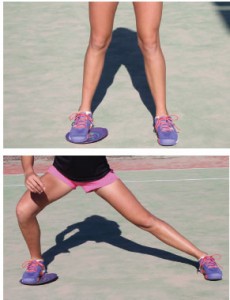 Glide disc slide lunge |
1. Glide disc slide lunge
- This exercise is great to strengthen the adductors – those muscles that are on the inside of your legs, which really get worked when playing on clay.
- Place a disc under one foot (You could even use a piece of plastic or cupboard – anything that can slide along the floor). Start to slide the leg out and go into a side lunge.
- Go out as far as comfortable and bring the leg back to the start position.
|
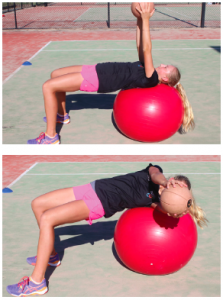 Russian twist |
2. Russian Twist
- This exercise is good for strengthening functional core strength and preventing injuries. With the increase in rally length and higher ball bounce on clay, it is imperative to have good core strength. This can help prevent any injuries that may occur when playing a number of matches in the week.
- Lying on the stability ball looking up, until your head, shoulders and upper back are resting on the ball.
- Knees should be bent to 90 degrees and your thighs and torso should be at or near parallel to the floor.
- Holding a medicine ball, slowly rotate your torso to one side until you end up resting on the outside of the shoulder.
- Focus on keeping your hips and torso parallel with the floor. Avoid the tendency to let your hips drop down. Push your feet into the floor and hips towards the ceiling to help maintain stability and control. Inhale and hold this position briefly before rotating to the opposite side.
|
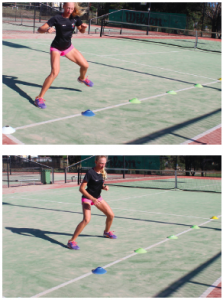 Lateral bound into lateral shuffle |
3. Lateral bound into lateral shuffle
- This drill is great for improving your deceleration or slide. In other words, your braking system. It’s important to learn how to slide. We always train for acceleration, however deceleration is just as (if not more) important than acceleration.
- Mark out six markers one metre apart. Start behind the second marker. Lateral bound to the first marker and lateral shuffle to the third marker.
- Then repeat, so lateral bound to the second marker and lateral shuffle to the fourth marker. Repeat all six markers.
- Focus on staying low and laterally exploding out of the legs on the bounds and then drive the legs with fast lateral shuffle steps.
|
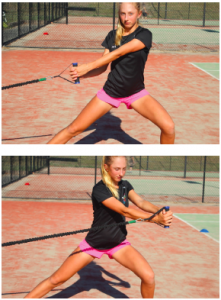 Cable side lunge rotation |
4. Cable side lunge rotation
- This exercise is great to get you ready for clay court tennis. It will help strengthen those muscles on the inside of the leg, which are heavily used in sliding. This exercise also gets the body used to holding tension through the rotational movement, while lengthening adductors.
- Start by holding a band or cable in both hands, take a step out to the side and once the outside foot is planted on the ground, rotate your torso over the outside leg.
- Slowly reverse the sequence and repeat.
- Maintain good posture and control.
|
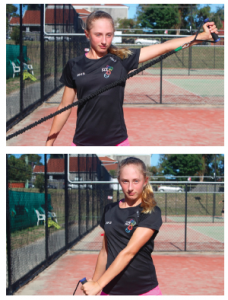 Reverse fly (single arm) |
5. Reverse fly (single arm)
- When playing on clay the ball has a higher ball bounce, and rallies are slightly longer than hard and grass court play. Taking this into consideration, it is very important to strengthen the back muscles as the contact point will be higher and more frequent. These back muscles can fatigue much easier with more volume. Performing this reverse fly will help strengthen those upper back muscles.
- Start by standing and having a band or cable fixed at chest height. Facing the fixed point, cross your hands over your body and grab the handles.
- Keeping your arms slightly bent, pull the bands back by using your upper back muscles and squeezing your shoulder blades together.
- Pull back as far as possible and slowly release back to the start then repeat.
|
Nathan and Giselle Martin, of Tennis Fitness, have been in the health and fitness industry for 20 years. They travelled on the WTA Tour for numerous years and also worked at the Sanchez Casal Tennis Academy in Barcelona, Spain. They’ve worked with Sam Stosur, Svetlana Kuznetsova, Jennifer Capriati, Arantxa Sanchez Vicario, Monica Seles and Martina Navratilova. The Sydney-based pair now work with Casey Dellacqua and Lleyton Hewitt. For further information and for previous month’s articles, visit tennisfitness.com.